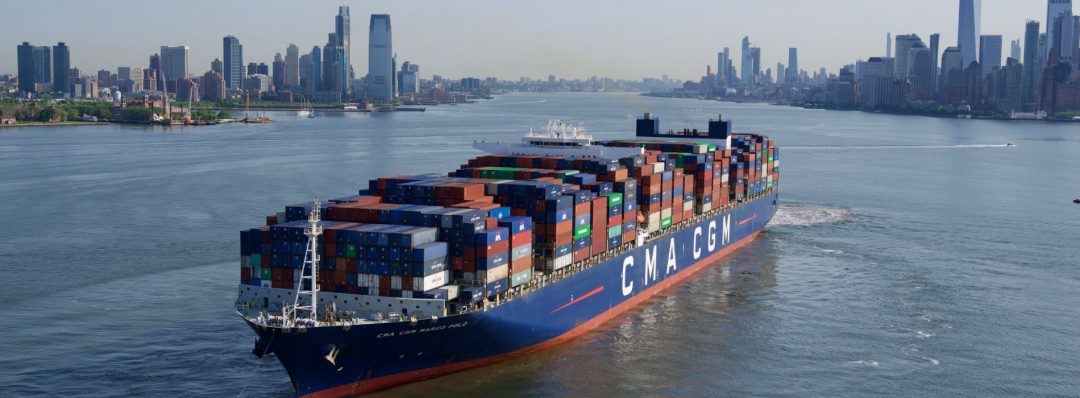The CMA CGM Group, a global player in sea, land, air and logistics solutions, has signed a binding agreement to acquire GCT Bayonne and New York terminals, currently held by Global Container Terminals Inc.
Two major East Coast terminals in one of the world’s largest economic regions
The Port of New York and New Jersey is a key entry point serving the Northeastern U.S. supply chain areas and represents CMA CGM’s largest gateway on the U.S. East and Gulf Coasts. The Bayonne and New York terminals, with an existing combined capacity of 2 million TEUs per year, have a potential for further expansion, up to almost double capacity.
While Bayonne terminal has the highest level of automation, the fastest truck turn time in the harbor, the closest ocean access, and an ability to service vessels of up to 18,000 TEUs, New York Terminal benefits from a highly productive labor force in the Port of New York and New Jersey and connects the dense New York hinterland with direct trucking and intermodal access.
A strategic investment supporting CMA CGM’s ambitions for the U.S. market
After closing, the CMA CGM Group will operate the two strategic facilities as multi-user terminals under the leadership of the current management team and will continue focusing on improving its service quality to satisfy U.S. customers’ expectations. Investment in the infrastructure will be undertaken to meet both CMA CGM and local communities’ environment protection targets.
CMA CGM intends to further develop its shipping line calls in the New York area for which the terminals will provide future capacity. The Group will significantly accelerate investments in the development of the Bayonne and New York terminals, with an objective to increase the combined capacity by up to 80 % in the coming years. This major acquisition will make it possible for CMA CGM Group to support U.S. East Coast supply chain growth and improve efficiency to and from the world.
Strengthening the Group’s position as a global port terminal operator
This major investment is consistent with CMA CGM Group’s strategy of developing its terminal business while supporting the growth and efficiency of its shipping lines and guaranteeing service quality for its clients.
With this acquisition, CMA CGM is bolstering its position as a leading global port terminal operator. Currently, the Group has investments in 52 port terminals in 28 countries, through CMA Terminals and its Terminal Link joint venture.
CMA CGM Group, a leading supply chain operator in the U.S. providing end-to-end services further expands its commitment to the U.S. economy
The CMA CGM Group has a long commitment to the U.S. economy and a strong presence through its port terminals portfolio and operational relationships with U.S. customers, including the U.S. government.
Over the past 12 months, the CMA CGM Group has significantly increased its presence in the U.S.:
- acquisition of Fenix Marine Services terminal in the Port of Los Angeles in January 2022,
- acquisition of Ingram Micro’s Commerce & Lifecycle Services business specializing in eCommerce contract logistics and omni-channel fulfillment, in April 2022.
GCT Terminals will complement CMA CGM’s capabilities, including:
- 24 shipping lines,
- A fleet of 9 U.S. flagged vessels operated under the American President Lines (APL) Lines brand, a trusted partner to the US government for ocean transportation and in country logistics for over a century,
- A portfolio of 5 terminal assets consisting of FMS (100%) and PMS (10%) in the Los Angeles area, Dutch Harbor (100%) in Alaska,
- Bayport (26%) in Houston and SFCT (26%) in Miami,
- CEVA Logistics, a world leader in third party logistics.
- CMA CGM began its operations in the country in the late 80’s and opened its U.S. headquarters in Norfolk in 2005. The Group currently employs more than 15,000 people in the U.S.
The closing of this transaction remains subject to the approval of the competent regulatory authorities.
Rodolphe Saadé, Chairman and CEO of the CMA CGM Group, said: “The acquisition of GCT Bayonne and GCT New York terminals is a strategic investment for the CMA CGM Group. It reinforces the services we provide to U.S. customers and their supply chain efficiency. It further consolidates our positions in the United States, a major market among the fastest-growing worldwide, and will help us continue our development.”

























